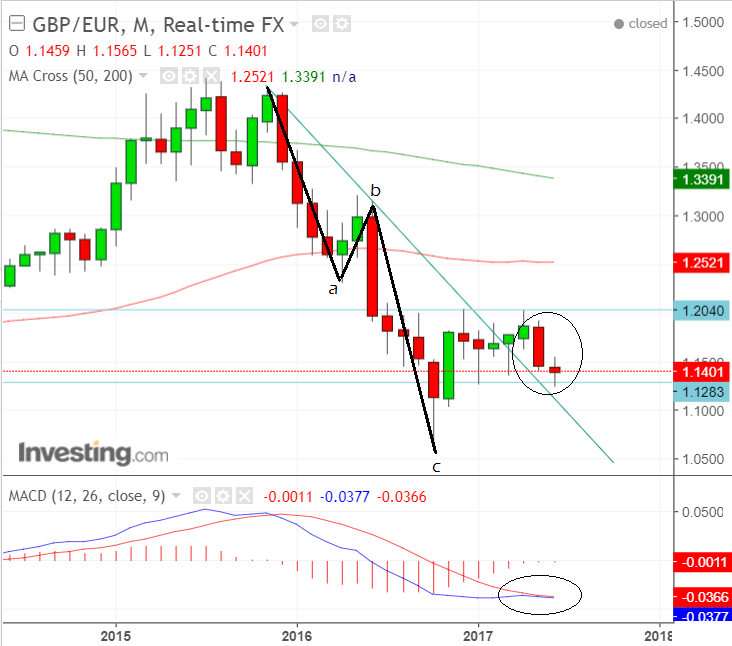This Could be an 'Up Month' for GBP/EUR Exchange Rate

- Euro to Pound Sterling exchange rate: 0.8772, day's best rate: 0.8809, low: 0.8761
- Pound to Euro exchange rate: 1.1401, day's best rate: 1.1414, low: 0.8761
Pound Sterling looks steady at the start of July, with the currency refusing to yield further ground to the Euro.
The Pound buys 1.1379 Euro's on the inter-bank market today with your retail bank account likely to offer rates of between 1.1060 and 1.0981 for international payments while independent specialists are seen offering better rates towards 1.13.
Can we expect even better exchange rates anytime soon?
Concerning the outlook, some relief for Sterling might in fact be on offer, for the next few weeks at least.
A good portion of big-name analysts have been resolutely negative with regards to the GBP/EUR outlook of late with many predicting further losses in light of ongoing Brexit uncertainty and domestic political woes.
But we find the majority of analysts are expecting more of the same, if not slightly higher rates, over coming weeks.
“Momentum loss and support around 1.1250 looks to be containing GBP weakness at present and while above here a range effectively persists despite longer-term downside risk,” notes technical analyst Lucy Lillicrap at Associated Foreign Exchange.
Technical analysts study a market’s structure as it tends to give clues to future direction on the assumption traders exhibit similar behaviour patterns when a rate reaches familiar territory.
“Looking ahead if this important demand-point gives way, sufficient compression already exists to enable an extension toward 1.0950 then 1.0800 areas next,” warns Lillicrap.
However, for now Sterling weakness might be put on hold and the Pound might flex its muscles and edge higher over coming days and weeks.
“Resistance appears relatively thin until 1.1600 or 1.1750,” says Lillicrap.
Our own studies of the weekly chart confirms a similar suspicion - that a relief-style rally back into Sterling-Euro’s recent range could be due before any big move lower transpires.
Since the start of the year the exchange rate has traded within the 1.1300 and 1.2000 area.
Pound Sterling Live’s Joaquin Monfort argues technical signs are bullish for GBP/EUR and he suggests the pair may start to move back up towards the 1.2000 range highs.

The last two down-months representing May and June - occurring as they did within an up-move from the October 2016 lows - were probably corrective in nature and Monfort says this suggests “July will be an up-month”.
Research has proven that when two down-months happen together within an up-move or trend, they normally represent a correction of the main trend, which reverses in the next month.
The set-up accurately predicts that the next month will be bullish to a 66% degree of probability.
The point finds some sympathy from Lillicrap.
“Some selling pressure is apparent in the 1.1450 region but this will probably not withstand much attention as Sterling values correct/digest recent weakness,” adds Lillicrap.
There is, therefore, "a higher than evens probability that we are beginning a bullish month for Sterling against the Euro," says Monfort.
Also note that the Euro's rally, while expected to extend on a longer-term basis, is looking a little old and extended at present.
Data suggests positive sentiment towards the Euro reached an extreme with 93% of traders bullish on Thursday June 29, before settling down to 82% at the start of the new month.
The last time the index reached this high was in February 2013, causing the ECB to intervene verbally. Over the following two months the Euro fell by 6.4% against the Dollar.
“Speculators needed a compelling reason to build long EUR positions to extend the currency’s appreciation,” says Philip Wee, an analyst with DBS in Singapore. “There is a risk that some of the bullish EUR bets put on in late June may need to be returned.”
Analyst Lloyds Wilkin at Lloyds Bank says, long-term, it is still unclear whether the Pound's recovery against the Euro from the "flash-crash" lows of October 2016 at 1.0299 are just corrective.
i.e. is this just a recovery rally from that sharp fall that must ultimately yield to the dominant downtrend?
Wilkin says if this is indeed the case then the market is ultimately set for an eventual re-test of the 2008 lows at 1.0202.
The warning serves as a reminder of the broader, underlying forces weighing on Sterling.
Euro Rally is Here to Stay Long-Term
Of concern to those hoping for a stronger Pound will be the view that the Euro is starting to build up a head of steam.
The Euro is already the best-performing currency amongst a group of the world's ten biggest currencies thanks to a combination of improving growth in the Eurozone economy and faded political risks. As a result, the European Central Bank that believes its job of stimulating the region's economy is almost done.
"The EUR rally has set in," says Morgan Stanley FX Strategist Hans Redeker. "The ECB's Draghi turning from ‘ultra-dovish’ to ‘moderately hawkish.’"
In June we saw Draghi tell the ECB Forum on Central Banking held in Sintra, Portugal, that the threat of deflation has gone and that deflationary forces have been replaced by reflationary forces.
Redeker says these comments are meaningful and, "with the hindsight of the market reaction, well-timed.”
Morgan Stanley believe the Euro has more potential to grow.
We find the key question to be whether the lion's share of the Euro's strength comes against the Dollar or the Pound.
Based on the technicals mentioned above, the Dollar looks most at risk.
Latest Data Below Par, but no Train Wreck
Pound Sterling was seen holding ground against the Euro and Dollar on Wednesday, July 5 following the release of this week's most important economic data.
Services PMI data from IHS Markit at the CIPS read at 53.4, a shave lower than the 53.4 economists were expecting. This represents a slight drop from the 53.8 seen in the previous month.
The services sector accounts for about 80% of the UK economy and employs over 80% of the workforce and is therefore a much-watched gauge of economic activity.
The general rule of thumb from a currency perspective is that were the data to beaten the Pound rises, if it were to come in lower the Pound would fall.
That Sterling is more or less unchanged reflects the fact that the data release came in on target.
“Sterling continues to march sideways against the euro and is unable to sustain a level above 1.30 against the US dollar,” says Carl Hasty, CEO at Smart Currency Exchange.
